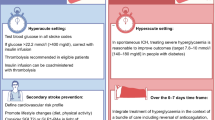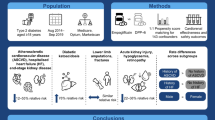Summary
Patients with diabetes mellitus are often not recognized in clinical routine, but also not well characterized in clinical trials.
As a diagnostic approach it is recommended to test fasting glucose and glycosylated hemoglobin (HbA1c) in every patient with coronary artery disease (CAD). HbA1c, in addition, provides important prognostic information.
Patients with diabetes mellitus do have an enhanced cardiovascular risk in all stages and during all kind of interventions of CAD. However, diabetes is not equal to diabetes; risk modifying factors such as HbA1c, concomitant diseases and medication have to be considered.
Absolute benefit of pharmacological therapies is also enhanced in patients with diabetes compared to non-diabetics. However, statins or anti-hypertensive treatment seem to be even more effective in reducing cardiovascular events than pure control of glucose levels alone. During percutaneous interventions (PCI) glycoprotein IIb/IIIa—inhibitors reduce mortality in diabetics, an effect which may be partially also achieved by Clopidogrel. Glitazones reduce restenosis rates; however, clinical end point studies are still ongoing.
After PCI, restenosis may be a predictor of mortality in patients with diabetes. Whether drug eluting stents, besides effectively reducing restenosis, may also reduce hard clinical events in patients with diabetes remains to be demonstrated. Current available studies comparing PCI with bypass are limited due to not considered factors (stenosis morphology), randomization bias, and faster progress of technology compared to study termination.
During an acute coronary syndrome/myocardial infarction, hyperglycemia is an adverse prognostic marker. However, so far studies using glucose-insulin-potassium (GIK) infusion have not been convincingly demonstrate to be beneficial.
Zusammenfassung
Patienten mit Diabetes mellitus bleiben in der klinischen Praxis oftmals unerkannt und sind in Studien häufig schlecht charakterisiert.
Als diagnostische Minimalmaßnahme ist es sinnvoll, bei jedem Patienten mit einer KHK—unabhängig davon, ob ein Diabetes mellitus bereits bekannt ist—einen HbA1c-Wert (Prognosemarker) und die Nüchternglucose zu bestimmen.
Patienten mit Diabetes mellitus haben ein höheres Risiko in allen Stadien und bei allen Interventionen der koronaren Herzkrankheit. Aber Diabetes mellitus ist nicht gleichzusetzen mit Diabetes mellitus. Modifizierende Faktoren wie HbA1c, Begleiterkrankung, Begleitmedikation sind zu berücksichtigen.
Patienten mit Diabetes mellitus haben einen größeren Nutzen von Pharmaka wie Statinen und Antihypertonika, wobei die Lipidsenkung und antihypertensive Therapie mindestens genauso—möglicherweise sogar effektiver—in der Prävention von kardiovaskulären Erkrankungen sind als die reine Glucose-Einstellung.
Im Rahmen der Intervention ist die Gabe von Glykoprotein-IIb/IIIa-Rezeptorblockern und Clopidogrel nützlich. Neuere Studien weisen auch auf einen Nutzen von Glitazone hin (Restenose-Reduktion), wobei klinische Endpunktstudien derzeit noch ausstehen.
Bei koronarer Revaskularisation ist die Restenose bei Patienten mit Diabetes mellitus möglicherweise mit einer erhöhten Mortalität assoziiert. Inwiefern Drug Eluting Stents, welche die Restenose signifikant reduzieren, auch mit einem prognostischen Vorteil bezüglich kardiovaskulärer Ereignisse assoziiert sind, ist derzeit noch offen. Bisherige Vergleichsstudien zwischen PTCA und Bypassoperationen bei Patienten mit Diabetes mellitus sind durch nichtberücksichtigte Faktoren (z. B. Koronarmorphologie, Randomisationsbias und einem schnelleren Fortschritt des aktuellen Stands der Revaskularisation als im Vergleich zu den Studien) limitiert.
Eine Hyperglykämie ist auch prognostisch ungünstig bei Patienten mit akutem Koronarsyndrom/Myokardinfarkt. Die Glucose-Insulin-Kalium(GIK)-Therapie muss allerdings nach der aktuellen Studienlage nicht empfohlen werden.
Similar content being viewed by others
References
Clinical Practice Recommendations 2005 (2005) Diabetes Care 28 (Suppl 1):S1–79
Babapulle MN, Joseph L, Belisle P et al (2004) A hierarchical Bayesian meta-analysis of randomised clinical trials of drug-eluting stents. Lancet 364:583–591
Bartnik M, Ryden L, Ferrari R et al (2004) The prevalence of abnormal glucose regulation in patients with coronary artery disease across Europe. The Euro Heart Survey on diabetes and the heart. Eur Heart J 25:1880–1890
Bhatt DL, Marso SP, Lincoff AM et al (2000) Abciximab reduces mortality in diabetics following percutaneous coronary intervention. J Am Coll Cardiol 35:922–928
Cameron A, Davis KB, Green G et al (1996) Coronary bypass surgery with internal-thoracic-artery grafts–effects on survival over a 15-year period. N Engl J Med 334:216–219
Colhoun HM, Betteridge DJ, Durrington PN et al (2004) Primary prevention of cardiovascular disease with atorvastatin in type 2 diabetes in the Collaborative Atorvastatin Diabetes Study (CARDS): multicentre randomised placebo-controlled trial. Lancet 364:685–696
Detre KM, Guo P, Holubkov R et al (1999) Coronary revascularization in diabetic patients: a comparison of the randomized and observational components of the Aypass Angioplasty Revascularization Investigation (BARI). Circulation 99:633–640
Downs JR, Clearfield M, Weis S et al (1998) Primary prevention of acute coronary events with lovastatin in men and women with average cholesterol levels: results of AFCAPS/Tex-CAPS. Air Force/Texas Coronary Atherosclerosis Prevention Study. JAMA 279:1615–1622
Endo M, Tomizawa Y, Nishida H (2003) Bilateral versus unilateral internal mammary revascularization in patients with diabetes. Circulation 108:1343–1349
Executive Summary of The Third Report of The National Cholesterol Education Program (NCEP) (2001) Expert Panel on Detection, Evaluation, And Treatment of High Blood Cholesterol In Adults (Adult Treatment Panel III). JAMA. 285:2486–2497
Fadini GP, Miorin M, Facco M et al (2005) Circulating endothelial progenitor cells are reduced in peripheral vascular complications of type 2 diabetes mellitus. J Am Coll Cardiol. 45:1449–1457
Flaherty JD, Davidson CJ (2005) Diabetes and coronary revascularization. JAMA 293:1501–1508
Gaede P, Vedel P, Larsen N et al (2003) Multifactorial intervention and cardiovascular disease in patients with type 2 diabetes. N Engl J Med 348:383–393
Haffner SM, Alexander CM, Cook TJ et al (1999) Reduced coronary events in simvastatin-treated patients with coronary heart disease and diabetes or impaired fasting glucose levels: subgroup analyses in the Scandinavian Simvastatin Survival Study. Arch Intern Med 159:2661–2667
Haffner SM, Lehto S, Ronnemaa T et al (1998) Mortality from coronary heart disease in subjects with type 2 diabetes and in nondiabetic subjects with and without prior myocardial infarction. N Engl J Med 339:229–234
Hansson GK (2005) Inflammation, atherosclerosis, and coronary artery disease. N Engl J Med 352:1685–1695
Hermiller JB, Raizner A, Cannon L et al (2005) Outcomes with the polymer-based paclitaxel-eluting TAXUS stent in patients with diabetes mellitus: the TAXUS-IV trial. J Am Coll Cardiol 45:1172–1179
Hirotani T, Kameda T, Kumamoto T et al (1999) Effects of coronary artery bypass grafting using internal mammary arteries for diabetic patients. J Am Coll Cardiol 34:532–538
Hu G, Jousilahti P, Qiao Q et al (2005) The gender-specific impact of diabetes and myocardial infarction at baseline and during follow-up on mortality from all causes and coronary heart disease. J Am Coll Cardiol 45:1413–1418
Huang ES, Meigs JB, Singer DE (2001) The effect of interventions to prevent cardiovascular disease in patients with type 2 diabetes mellitus. Am J Med 111:633–642
Kastrati A, Mehilli J, Schuhlen H et al (2004) A clinical trial of abciximab in elective percutaneous coronary intervention after pretreatment with clopidogrel. N Engl J Med 350:232–238
Khan NE, De Souza A, Mister R et al (2004) A randomized comparison of off-pump and on-pump multivessel coronary-artery bypass surgery. N Engl J Med 350:21–28
Khaw KT,Wareham N, Bingham S et al (2004) Association of hemoglobin A1c with cardiovascular disease and mortality in adults: the European prospective investigation into cancer in Norfolk. Ann Intern Med 141:413–420
Kosiborod M, Rathore SS, Inzucchi SE et al (2005) Admission Glucose and Mortality in Elderly Patients Hospitalized With Acute Myocardial Infarction. Implications for Patients With and Without Recognized Diabetes. Circulation.
Laufs U, La F, V, Plutzky J et al (1998) Upregulation of endothelial nitric oxide synthase by HMG CoA reductase inhibitors. Circulation 97:1129–1135
Lee CD, Folsom AR, Pankow JS et al (2004) Cardiovascular events in diabetic and nondiabetic adults with or without history of myocardial infarction. Circulation 109:855–860
Legrand VM, Serruys PW, Unger F et al (2004) Three-year outcome after coronary stenting versus bypass surgery for the treatment of multivessel disease. Circulation 109:1114–1120
Magee MJ, Dewey TM, Acuff T et al (2001) Influence of diabetes on mortality and morbidity: off-pump coronary artery bypass grafting versus coronary artery bypass grafting with cardiopulmonary bypass. Ann Thorac Surg 72:776–780
Markwirth T, Hennen B, Scheller B et al (2000) Complete arterial revascularization using T-graft technique in diabetics with coronary three-vessel disease. Thorac Cardiovasc Surg 48:269–273
Mathew V, Gersh BJ, Williams BA et al (2004) Outcomes in patients with diabetes mellitus undergoing percutaneous coronary intervention in the current era: a report from the Prevention of REStenosis with Tranilast and its Outcomes (PRESTO) trial. Circulation 109:476–480
Mehilli J, Kastrati A, Schuhlen H et al (2004) Randomized clinical trial of abciximab in diabetic patients undergoing elective percutaneous coronary interventions after treatment with a high loading dose of clopidogrel. Circulation 110:3627–3635
Mehta SR, Yusuf S, Diaz R et al (2005) Effect of glucose-insulin-potassium infusion on mortality in patients with acute ST-segment elevation myocardial infarction: the CREATE-ECLA randomized controlled trial. JAMA 293:437–446
Morgan KP, Kapur A, Beatt KJ (2004) Anatomy of coronary disease in diabetic patients: an explanation for poorer outcomes after percutaneous coronary intervention and potential target for intervention. Heart 90:732–738
Muneretto C, Bisleri G, Negri A et al (2003) Total arterial myocardial revascularization with composite grafts improves results of coronary surgery in elderly: a prospective randomized comparison with conventional coronary artery bypass surgery. Circulation 108(Suppl 1):II29–II33
Norhammar A, Tenerz A, Nilsson G et al (2002) Glucose metabolism in patients with acute myocardial infarction and no previous diagnosis of diabetes mellitus: a prospective study. Lancet 359:2140–2144
Pittas AG, Siegel RD, Lau J (2004) Insulin therapy for critically ill hospitalized patients: a meta-analysis of randomized controlled trials. Arch Intern Med 164:2005–2011
Pradhan AD, Manson JE, Rifai N et al (2001) C-reactive protein, interleukin 6, and risk of developing type 2 diabetes mellitus. JAMA 286:327–334
Roffi M, Topol EJ (2004) Percutaneous coronary intervention in diabetic patients with non-ST-segment elevation acute coronary syndromes. Eur Heart J 25:190–198
Schatteman GC, Hanlon HD, Jiao C et al (2000) Blood-derived angioblasts accelerate blood-flow restoration in diabetic mice. J Clin Invest 106:571–578
Schmidt-Lucke C, Rossig L, Fichtlscherer S et al (2005) Reduced number of circulating endothelial progenitor cells predicts future cardiovascular events: proof of concept for the clinical importance of endogenous vascular repair. Circulation 111:2981–2987
Schonbeck U, Libby P (2004) Inflammation, immunity, and HMG-CoA reductase inhibitors: statins as antiinflammatory agents? Circulation 109:II18–II26
Stuckey TD, Stone GW, Cox DA et al (2005) Impact of stenting and abciximab in patients with diabetes mellitus undergoing primary angioplasty in acute myocardial infarction (the CADILLAC trial). Am J Cardiol 95:1–7
Taggart DP, D’Amico R, Altman DG (2001) Effect of arterial revascularisation on survival: a systematic review of studies comparing bilateral and single internal mammary arteries. Lancet 358:870–875
Timmer JR, Ottervanger JP, de Boer MJ et al (2005) Hyperglycemia is an important predictor of impaired coronary flow before reperfusion therapy in ST-segment elevation myocardial infarction. J Am Coll Cardiol 45:999–1002
Van Belle E, Ketelers R, Bauters C et al (2001) Patency of percutaneous transluminal coronary angioplasty sites at 6-month angiographic follow-up: A key determinant of survival in diabetics after coronary balloon angioplasty. Circulation 103:1218–1224
Van Belle E, Perie M, Braune D et al (2002) Effects of coronary stenting on vessel patency and long-term clinical outcome after percutaneous coronary revascularization in diabetic patients. J Am Coll Cardiol 40:410–417
van der Schaaf RJ, Henriques JP, Wiersma JJ et al (2005) Primary PCI for acute STEMI patients with and without diabetes mellitus. Heart
Vasa M, Fichtlscherer S, Adler K et al (2001) Increase in circulating endothelial progenitor cells by statin therapy in patients with stable coronary artery disease. Circulation 103:2885–2890
Wellen KE, Hotamisligil GS (2005) Inflammation, stress, and diabetes. J Clin Invest 115:1111–1119
West NE, Ruygrok PN, Disco CM et al (2004) Clinical and angiographic predictors of restenosis after stent deployment in diabetic patients. Circulation 109:867–873
Yudkin JS, Stehouwer CD, Emeis JJ et al (1999) C-reactive protein in healthy subjects: associations with obesity, insulin resistance, and endothelial dysfunction: a potential role for cytokines originating from adipose tissue? Arterioscler Thromb Vasc Biol 19:972–978
Author information
Authors and Affiliations
Corresponding author
Rights and permissions
About this article
Cite this article
Schächinger, V., Britten, M.B. & Zeiher, A.M. Diabetes mellitus und koronare Herzkrankheit. Clin Res Cardiol 95 (Suppl 1), i18–i26 (2006). https://doi.org/10.1007/s00392-006-1115-y
Issue Date:
DOI: https://doi.org/10.1007/s00392-006-1115-y




